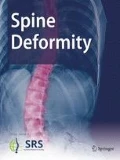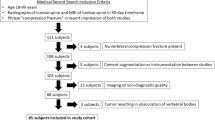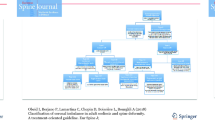Abstract
Purpose
To propose a complementary classification to the Schwab’s osteotomy classification that would regroup together under a common umbrella different published pedicle subtraction osteotomy (PSO) variations that are commonly used, to have a common language and complete the spine surgeon’s armamentarium when dealing with rigid spinal deformities.
Methods
The 2 general types corresponding to the grades 3 and 4 of the Schwab classification were separated into 6 gradual subtypes (grades 3A, 3B, 3C, 4A, 4B, 4C). The classification is based on the amount of resected pedicle, the inclusion or not of the disc above, and the location of the axis of rotation. Based on the proposed classification, a reliability study was performed using 18 cases that were classified by 8 readers with expertise in the management of adult deformities with the use of osteotomies.
Results
Clinical cases were classified according to the 6 grades proposed in the classification. The intra-rater reliability for the classification was “almost perfect agreement” with a Fleiss kappa coefficient average of 0.92 (range 0.85–1.00). The inter-rater reliability was “almost perfect agreement” with a coefficient average of 0.90 for the 2 readings that were done at an interval of 2 weeks.
Conclusion
The developed classification proved to be reliable and intuitive. It is an original way to display a catalog of different available PSO modifications including the original technique, in a logical and gradual order to help the surgeons in their decisions and show them that between a grade 2 osteotomy and a grade 5 osteotomy, many intermediate options are available. Further work with a treatment algorithm for clinical practice based on the current classification may be developed in the future.







Similar content being viewed by others
References
Thomasen E (1985) Vertebral osteotomy for correction of kyphosis in ankylosing spondylitis. Clin Orthop Relat Res 194:142–152
Jaffray D, Becker V, Eisenstein S (1992) Closing wedge osteotomy with transpedicular fixation in ankylosing spondylitis. Clin Orthop Relat Res 279:122–126
van Royen BJ, Slot GH (1995) Closing-wedge posterior osteotomy for ankylosing spondylitis. Partial corporectomy and transpedicular fixation in 22 cases. J Bone Jt Surg Br 77:117–121
Thiranont N, Netrawichien P (1993) Transpedicular decancellation closed wedge vertebral osteotomy for treatment of fixed flexion deformity of spine in ankylosing spondylitis. Spine (Phila Pa 1976) 18:2517–2522
Bridwell KH, Lewis SJ, Lenke LG, Baldus C, Blanke K (2003) Pedicle subtraction osteotomy for the treatment of fixed sagittal imbalance. J Bone Jt Surg Am 85-A:454–463
Schwab F, Blondel B, Chay E, Demakakos J, Lenke L, Tropiano P, Ames C, Smith JS, Shaffrey CI, Glassman S, Farcy JP, Lafage V (2014) The comprehensive anatomical spinal osteotomy classification. Neurosurgery 74:112–120. https://doi.org/10.1227/NEU.0000000000000182o ((discussion 120))
Kim KT, Park DH, Lee SH, Suk KS, Lee JH, Park KJ (2013) Partial pedicle subtraction osteotomy as an alternative option for spinal sagittal deformity correction. Spine (Phila Pa 1976) 38:1238–1243. https://doi.org/10.1097/BRS.0b013e31828e0e56
Chang KW, Cheng CW, Chen HC, Chang KI, Chen TC (2008) Closing-opening wedge osteotomy for the treatment of sagittal imbalance. Spine (Phila Pa 1976) 33:1470–1477. https://doi.org/10.1097/BRS.0b013e3181753bcd
Mehdian H, Arun R, Aresti NA (2015) V–Y vertebral body osteotomy for the treatment of fixed sagittal plane spinal deformity. Spine J 15:771–776. https://doi.org/10.1016/j.spinee.2015.01.014
Hu W, Yu J, Liu H, Zhang X, Wang Y (2016) Y shape osteotomy in ankylosing spondylitis, a prospective case series with minimum 2 year follow-up. PLoS ONE 11:e0167792. https://doi.org/10.1371/journal.pone.0167792
Park JH, Hyun SJ, Kim KJ, Jahng TA (2017) Comparative study between pedicle subtraction osteotomy (PSO) and closing-opening wedge osteotomy (Fish-Mouth PSO) for sagittal plane deformity correction. Spine (Phila Pa 1976) 42:E899–E905. https://doi.org/10.1097/BRS.0000000000002007
Gao R, Wu J, Yuan W, Yang C, Pan F, Zhou X (2015) Modified partial pedicle subtraction osteotomy for the correction of post-traumatic thoracolumbar kyphosis. Spine J 15:2009–2015. https://doi.org/10.1016/j.spinee.2015.04.047
Liu FY, Gu ZF, Zhao ZQ, Ren L, Wang LM, Yu JH, Hou SB, Ding WY, Sun XZ (2020) Modified grade 4 osteotomy for the correction of post-traumatic thoracolumbar kyphosis: a retrospective study of 42 patients. Medicine (Baltimore) 99:e22204. https://doi.org/10.1097/MD.0000000000022204
Boachie-Adjei O, Ferguson JA, Pigeon RG, Peskin MR (2006) Transpedicular lumbar wedge resection osteotomy for fixed sagittal imbalance: surgical technique and early results. Spine (Phila Pa 1976) 31:485–492. https://doi.org/10.1097/01.brs.0000199893.71141.59
Bourghli A, Boissiere L, Vital JM, Bourghli MA, Almusrea K, Khoury G, Obeid I (2015) Modified closing-opening wedge osteotomy for the treatment of sagittal malalignment in thoracolumbar fractures malunion. Spine J 15:2574–2582. https://doi.org/10.1016/j.spinee.2015.08.062
Landis JR, Koch GG (1977) The measurement of observer agreement for categorical data. Biometrics 33:159–174
Booth KC, Bridwell KH, Lenke LG, Baldus CR, Blanke KM (1999) Complications and predictive factors for the successful treatment of flatback deformity (fixed sagittal imbalance). Spine (Phila Pa 1976) 24:1712–1720
Buell TJ, Nguyen JH, Mazur MD, Mullin JP, Garces J, Taylor DG, Yen CP, Shaffrey ME, Shaffrey CI, Smith JS (2018) Radiographic outcome and complications after single-level lumbar extended pedicle subtraction osteotomy for fixed sagittal malalignment: a retrospective analysis of 55 adult spinal deformity patients with a minimum 2-year follow-up. J Neurosurg Spine 30:242–252. https://doi.org/10.3171/2018.7.SPINE171367
Laouissat F, Sebaaly A, Gehrchen M, Roussouly P (2018) Classification of normal sagittal spine alignment: refounding the Roussouly classification. Eur Spine J 27:2002–2011. https://doi.org/10.1007/s00586-017-5111-x
Ponte A, Orlando G, Siccardi GL (2018) The True Ponte osteotomy: by the one who developed it. Spine Deform 6:2–11. https://doi.org/10.1016/j.jspd.2017.06.006
Turner JD, Akbarnia BA, Eastlack RK, Bagheri R, Nguyen S, Pimenta L, Marco R, Deviren V, Uribe J, Mundis GM Jr (2015) Radiographic outcomes of anterior column realignment for adult sagittal plane deformity: a multicenter analysis. Eur Spine J 24(Suppl 3):427–432. https://doi.org/10.1007/s00586-015-3842-0
Bodin A, Roussouly P (2015) Sacral and pelvic osteotomies for correction of spinal deformities. Eur Spine J 24(Suppl 1):S72-82. https://doi.org/10.1007/s00586-014-3651-x
Obeid I, Diebo BG, Boissiere L, Bourghli A, Cawley DT, Larrieu D, Pointillart V, Challier V, Vital JM, Lafage V (2017) Single level proximal thoracic pedicle subtraction osteotomy for fixed hyperkyphotic deformity: surgical technique and patient series. Oper Neurosurg (Hagerstown). https://doi.org/10.1093/ons/opx158
Tokala DP, Lam KS, Freeman BJ, Webb JK (2007) C7 decancellisation closing wedge osteotomy for the correction of fixed cervico-thoracic kyphosis. Eur Spine J 16:1471–1478. https://doi.org/10.1007/s00586-006-0290-x
Danisa OA, Turner D, Richardson WJ (2000) Surgical correction of lumbar kyphotic deformity: posterior reduction “eggshell” osteotomy. J Neurosurg 92:50–56
Thambiraj S, Boszczyk BM (2012) Asymmetric osteotomy of the spine for coronal imbalance: a technical report. Eur Spine J 21(Suppl 2):S225-229. https://doi.org/10.1007/s00586-012-2171-9
Wang Y, Zhang Y, Mao K, Zhang X, Wang Z, Zheng G, Li G, Wood KB (2010) Transpedicular bivertebrae wedge osteotomy and discectomy in lumbar spine for severe ankylosing spondylitis. J Spinal Disord Tech 23:186–191. https://doi.org/10.1097/BSD.0b013e3181a5abde
Enercan M, Ozturk C, Kahraman S, Sarier M, Hamzaoglu A, Alanay A (2013) Osteotomies/spinal column resections in adult deformity. Eur Spine J 22(Suppl 2):S254-264. https://doi.org/10.1007/s00586-012-2313-0
Funding
No funds were received for the current study.
Author information
Authors and Affiliations
Contributions
AB, FK, SA, AA, BPQ, YQ, KH, JP: none. LB: Consultant Spineart, Medicrea. CA: Consultant Depuy Synthes, Medtronic, Stryker, Medicrea, K2M and Zimmer Biomet, receipt of royalties from Stryker, Zimmer Biomet, Depuy Synthes, Nuvasive, K2M, Medicrea, Research support from Titan Spine, Depuy Synthes, and ISSG. JMV: Consultant Depuy Synthes, LDR. IO: Consultant Alphatec spine, Depuy Synthes and Medtronic, receives research support from Depuy Synthes, receipt of royalties from Alphatec, Clariance and Spineart. AB: conception, drafting, final approval, and agreement to be accountable for all aspects of the work. LB: conception, critical revision, final approval, and agreement to be accountable for all aspects of the work approval. FK: conception, drafting, final approval, and agreement to be accountable for all aspects of the work. SAE: interpretation of data, critical revision, final approval, and agreement to be accountable for all aspects of the work. AA-H: interpretation of data, critical revision, final approval, and agreement to be accountable for all aspects of the work. B-PQ: interpretation of data, critical revision, final approval, and agreement to be accountable for all aspects of the work. YQ: design, critical revision, final approval, and agreement to be accountable for all aspects of the work. KH interpretation of data, critical revision, final approval, and agreement to be accountable for all aspects of the work. JP: interpretation of data, critical revision, final approval, and agreement to be accountable for all aspects of the work. CA: design, critical revision, final approval, and agreement to be accountable for all aspects of the work. J-MV: design, critical revision, final approval, and agreement to be accountable for all aspects of the work. IO: design, critical revision, final approval, and agreement to be accountable for all aspects of the work.
Corresponding author
Ethics declarations
Conflict of interest
The authors declare that they have no conflict of interest.
Ethical approval
Institutional Review Board (IRB) approval was obtained prior to initiation of the study.
Informed consent
Patients signed informed consent regarding publishing their data and X-rays.
Additional information
Publisher's Note
Springer Nature remains neutral with regard to jurisdictional claims in published maps and institutional affiliations.
Rights and permissions
About this article
Cite this article
Bourghli, A., Boissière, L., Konbaz, F. et al. On the pedicle subtraction osteotomy technique and its modifications during the past two decades: a complementary classification to the Schwab’s spinal osteotomy classification. Spine Deform 9, 515–528 (2021). https://doi.org/10.1007/s43390-020-00247-6
Received:
Accepted:
Published:
Issue Date:
DOI: https://doi.org/10.1007/s43390-020-00247-6




